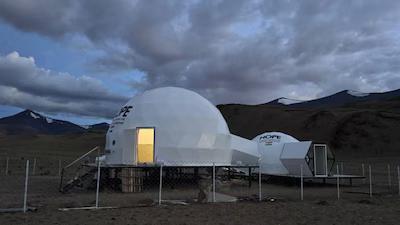
ISRO Sets Up Station in Ladakh to Simulate Life on Moon & Mars
In a groundbreaking move, the Indian Space Research Organisation (ISRO) has set up a special station in Ladakh’s Tso Kar Valley to simulate life on the Moon and Mars. The Himalayan Outpost for Planetary Exploration (HOPE) is a unique facility that will test life-support systems for future lunar and Martian missions. This ambitious project marks a significant milestone in India’s space exploration journey and demonstrates the country’s commitment to pushing the boundaries of space research.
The Tso Kar Valley was chosen as the perfect location for the HOPE station due to its extreme environmental conditions, which are similar to those found on Mars. The valley is characterized by high UV radiation, low atmospheric pressure, extreme cold, and saline permafrost – all of which will provide a challenging environment for the crew members who will be undertaking various tests at the facility.
The mission, which will run from August 1 to 10, will involve two crew members who will be stationed at HOPE for 10 days. During this period, they will conduct experiments and tests to simulate the conditions that astronauts will face on future lunar and Martian missions. The data collected during this mission will be crucial in refining the life-support systems for ISRO’s future space missions.
The HOPE station is equipped with state-of-the-art facilities and equipment that will enable the crew members to conduct a range of experiments. These include testing the oxygen generation system, life support systems, and communication equipment, among others. The crew members will also have to deal with the challenges of living in a remote and harsh environment, which will help ISRO to better understand the psychological and physical effects of long-duration space missions.
The Tso Kar Valley provides an ideal location for the HOPE station due to its unique environmental conditions. The valley is located at an altitude of over 4,500 meters and is characterized by low temperatures, high UV radiation, and extreme cold. The soil in the valley is also saline and contains permafrost, which is similar to the conditions found on Mars. These conditions will provide a challenging environment for the crew members, who will have to adapt to the harsh conditions and conduct their experiments effectively.
The HOPE mission is part of ISRO’s larger plan to explore the Moon and Mars. The organization has already successfully conducted several missions to the Moon, including the Chandrayaan-1 mission, which was launched in 2008. ISRO is also planning to launch its second lunar mission, Chandrayaan-3, in the near future, which will involve a soft landing on the Moon’s surface.
ISRO’s plans to explore Mars are even more ambitious. The organization has already launched its first Mars mission, Mangalyaan, in 2013, which was a major success. The mission included a orbiter that was designed to study the Martian atmosphere and geology. ISRO is now planning to launch its second Mars mission, Mangalyaan-2, which will involve a rover that will be designed to explore the Martian surface.
The HOPE mission is an important step towards achieving these goals. By testing life-support systems and simulating the conditions that astronauts will face on future lunar and Martian missions, ISRO can refine its technologies and prepare its crew members for the challenges of space travel.
In conclusion, the HOPE station in Ladakh’s Tso Kar Valley is an important milestone in ISRO’s journey to explore the Moon and Mars. The unique environmental conditions of the valley provide an ideal location for testing life-support systems and simulating the conditions that astronauts will face on future space missions. The HOPE mission is an important step towards achieving ISRO’s goals and demonstrates the organization’s commitment to pushing the boundaries of space research.
Source:






